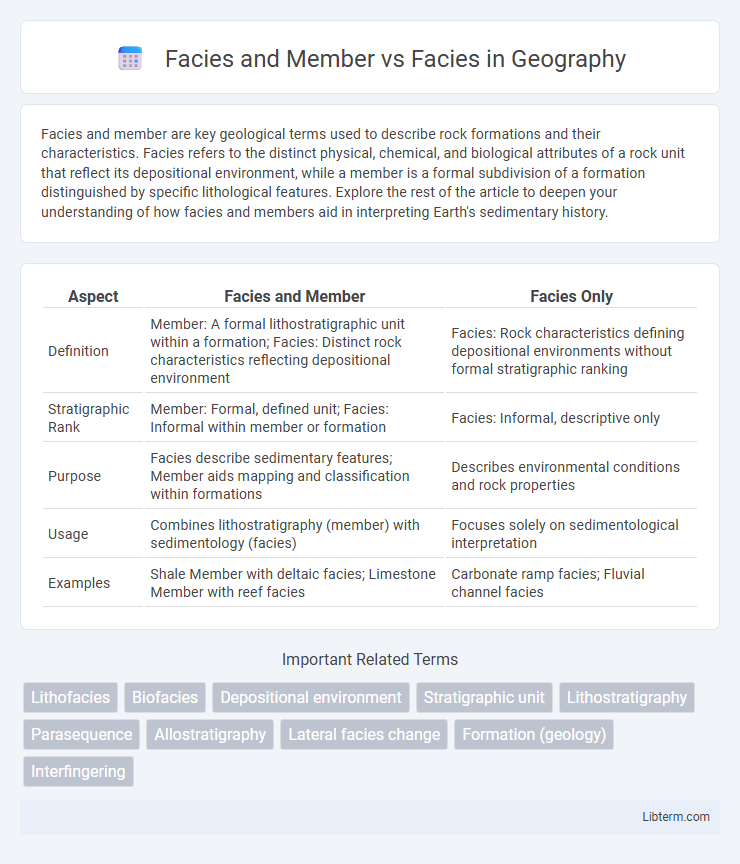Facies and member are key geological terms used to describe rock formations and their characteristics. Facies refers to the distinct physical, chemical, and biological attributes of a rock unit that reflect its depositional environment, while a member is a formal subdivision of a formation distinguished by specific lithological features. Explore the rest of the article to deepen your understanding of how facies and members aid in interpreting Earth's sedimentary history.
Table of Comparison
| Aspect | Facies and Member | Facies Only |
|---|---|---|
| Definition | Member: A formal lithostratigraphic unit within a formation; Facies: Distinct rock characteristics reflecting depositional environment | Facies: Rock characteristics defining depositional environments without formal stratigraphic ranking |
| Stratigraphic Rank | Member: Formal, defined unit; Facies: Informal within member or formation | Facies: Informal, descriptive only |
| Purpose | Facies describe sedimentary features; Member aids mapping and classification within formations | Describes environmental conditions and rock properties |
| Usage | Combines lithostratigraphy (member) with sedimentology (facies) | Focuses solely on sedimentological interpretation |
| Examples | Shale Member with deltaic facies; Limestone Member with reef facies | Carbonate ramp facies; Fluvial channel facies |
Introduction to Facies in Geology
Facies in geology describe distinct bodies of rock with specific characteristics representing particular depositional environments, providing insights into past geological conditions. Members are formal stratigraphic units within formations, often containing multiple facies that reflect variations in sedimentation or depositional settings. Understanding facies allows geologists to interpret depositional processes, paleoenvironments, and stratigraphic relationships, while distinguishing members helps organize stratigraphic records based on lithologic changes.
Defining Facies: Concepts and Importance
Facies represent distinct rock units characterized by specific lithological, paleontological, or sedimentological features that reflect particular depositional environments. Members are subdivisions within formations that group similar facies to better understand local stratigraphy and sedimentary processes. Defining facies is crucial for interpreting depositional settings, reconstructing paleoenvironments, and guiding hydrocarbon exploration by distinguishing variations in rock properties and reservoir quality.
Types of Facies: Lithofacies and Biofacies
Facies classification distinguishes Lithofacies and Biofacies to analyze sedimentary environments and fossil content respectively. Lithofacies refers to the physical and compositional characteristics of rock units, such as grain size, mineralogy, and sedimentary structures, while Biofacies focuses on fossil assemblages and their ecological implications within the rock. Understanding the difference between Facies and Member involves recognizing that Members are formal stratigraphic units within formations, whereas Facies represent variations in sedimentary features or fossil content that reflect depositional conditions.
Stratigraphic Member: Definition and Significance
Stratigraphic members are formal subdivisions of rock formations characterized by distinct lithological features, crucial for detailed geological mapping and correlation. Unlike facies, which describe the varying physical, chemical, and biological attributes of sedimentary deposits reflecting changing environments, members serve as mappable units aiding in stratigraphic classification and resource exploration. Understanding the distinction enhances interpretation of depositional histories and facilitates precise stratigraphic framework construction.
Relationship Between Facies and Member
The relationship between facies and member is hierarchical, where a member is a formal lithostratigraphic unit within a formation, and facies describe the distinct characteristics of sedimentary deposits within that member. Facies reflect variations in depositional environments and can be identified by physical, chemical, and biological attributes, whereas members group these facies into recognizable, mappable units. Understanding the interaction between facies and members allows geologists to interpret geological history and depositional processes at different spatial scales.
Facies vs Member: Key Differences
Facies represent distinct bodies of rock with specific characteristics reflecting depositional environments, whereas members are formal stratigraphic units within formations, defined by lithologic properties. Facies emphasize environmental interpretations and sedimentary processes, while members serve as hierarchical classification units used to organize rock layers. Understanding the difference between facies and members is crucial for accurate geological mapping and sedimentological analysis.
Criteria for Distinguishing Facies and Members
Facies are identified based on distinctive lithological, paleontological, and sedimentological criteria reflecting specific depositional environments, allowing geologists to interpret strata variations. Members represent formal subdivisions within a formation, distinguished by consistent lithological characteristics and boundaries, often exhibiting more uniform physical properties compared to facies. Criteria for distinguishing facies emphasize environmental and textural changes, while members focus on mappable, lithostratigraphic units with defined stratigraphic position and compositional consistency.
Practical Applications: Mapping Facies and Members
Mapping facies and members involves detailed sedimentological analysis to distinguish lithological units within stratigraphic sections, enhancing reservoir characterization and paleoenvironmental reconstruction. Practical applications include identifying heterogeneities in hydrocarbon reservoirs, guiding well placement, and improving geological models by correlating facies distributions with depositional environments. Facies mapping emphasizes sedimentary features and depositional settings, whereas member mapping focuses on formally defined stratigraphic units within formations, both crucial for accurate subsurface interpretations.
Case Studies: Facies and Members in Real-World Stratigraphy
Case studies in real-world stratigraphy demonstrate that facies represent distinct rock units characterized by specific depositional environments, while members are formal subdivisions within formations, often defined by distinctive facies changes. For example, the Navajo Sandstone formation contains multiple members distinguished by varying facies, such as eolian dunes and interdune deposits, each reflecting different sedimentary processes. Understanding these distinctions aids in reconstructing paleoenvironments and correlating stratigraphic units across regions more accurately.
Conclusion: Integrating Facies and Member Analysis
Integrating facies and member analysis enhances geological interpretation by correlating sedimentary characteristics with stratigraphic units, improving reservoir characterization and depositional environment understanding. Analyzing facies within members allows precise identification of lithological variations and depositional trends, aiding in accurate stratigraphic correlation and resource assessment. This combined approach facilitates comprehensive subsurface modeling and efficient hydrocarbon exploration.
Facies and Member Infographic

 libterm.com
libterm.com